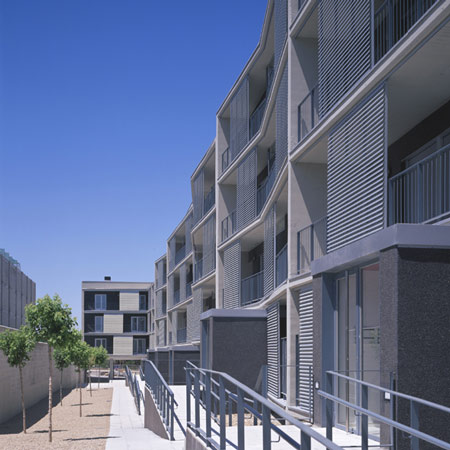Spanish office Magén Arquitectos have completed a social housing project in Zaragoza, Spain.
Called 68 Social Housing, the long four-storey building is staggered in three sections to allow for the sloping site.
Situated on the edge of the city, the north facade has smaller windows while terraces on the south side overlook an open area.
Mobile aluminium panels can be positioned to provide shade for the apartments in summer or admit more light in the winter.
Photographs are by Roland Halbe
Here's some text from Magén Arquitectos:
--
SOCIAL HOUSING AT THE URBAN EDGE. ZARAGOZA, SPAIN
The project develops a residential programme for social housing units of different types and surface areas, in a longitudinal building with ground floor plus three storeys, staggered in three sections to adapt to the steep slope of the location.
The situation of the site, on the southern limit between the built-up area of the city and open landscape, and the longitudinal dimensions of the building form a piece on the edge of the city that responds in a different manner to the obvious differences in the conditions of the surrounding area. The orientation of the building supports the idea of contrast between the north facing closed and massive exterior, and the south facing, broken up and open interior, and the views.
Click for larger image
The housing units participate of this dual orientation, with the bedrooms overlooking the street, to the north, and the daytime rooms, living rooms and kitchens, facing the interior garden space, to the south. The services strip occupies a central position that permits dual traffic around it, as well as extending the line of sight on the inside of the home, affording a greater impression of amplitude for its reduced surface area.
Click for larger image
On the outside, the building has a closed, opaque configuration, in an attempt to adapt and discretely integrate into the immediate surroundings –a group of social homes from the sixties. The outer façades follow regulatory alignments and are configured based on the window openings and their repetition in series. These enclosures are built with white brick and a base on the ground floor of prefabricated concrete panels, which solve the encounter of the building with the steep slope of the pavement and extend through the access porches to the interior.
Click for larger image
At the points where the building is reduced in height to adapt to the slope and, at the end of the block, there are some spacious access porches or hallways, which connect the public highway to the interior garden space, where the accesses to the homes are located. This intermediate interior space, an area of access, meeting and connection, creates a sequence between the public and the private space. The differences in levels, both in the accesses and in the interior patio, given the slope of the land, are solved by inclining planes with a gentle slope and access ramps to the front doors.
Click for larger image
Over the interior space, the building is characterised by a series of broken up sections of wall defined by a polygon. An undressed structure of slabs and concrete screens configure an intermediate space that connects the homes to the exterior, in front of the daytime rooms. The enclosures of these spaces and the doors, whose volumes on the ground floor indicate the accesses, are characterised by a finish in single-layer black stone.
Click for larger image
The different guidelines of the façade and the variable positions of the sliding aluminium slat panels, depending on their possible use in front of the kitchen or living room, provide the façade with movement and a changing aspect throughout the day.
The configuration of the building favours good thermal performance: the closed and massive north façade insulates from the environmental noise and provide thermal inertia, whilst, to the south, the aluminium slats, the slabs of the terraces and the deciduous leaved trees bathe the homes with sun in winter and protect them from it in summer.

